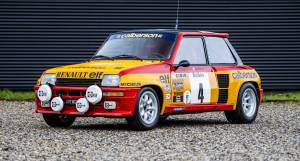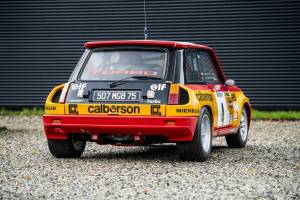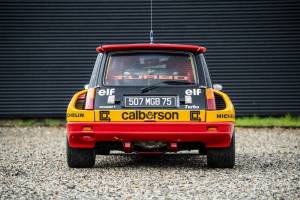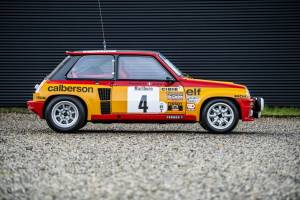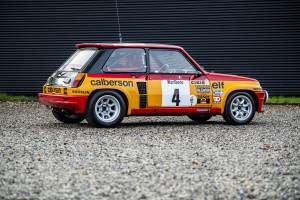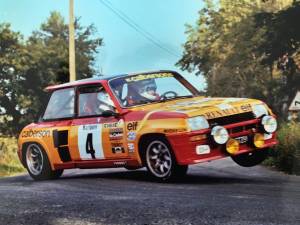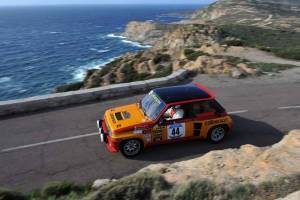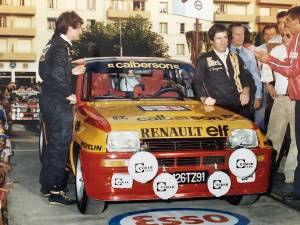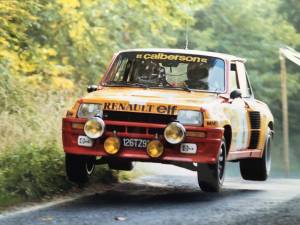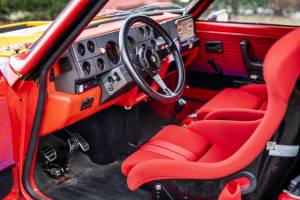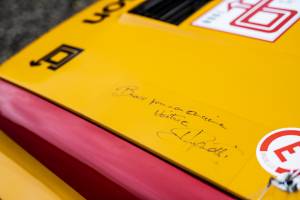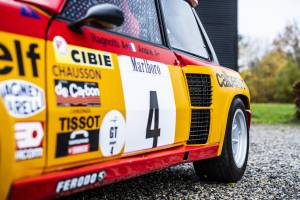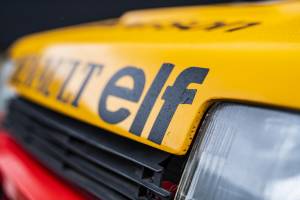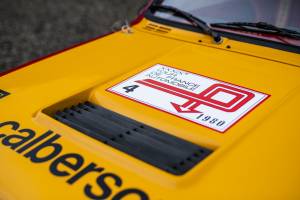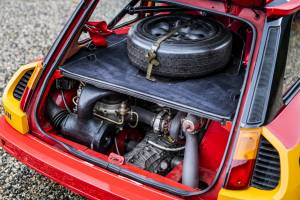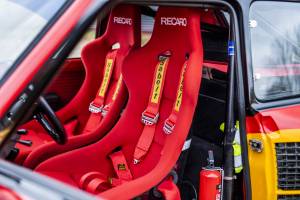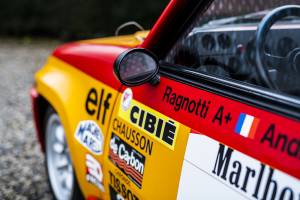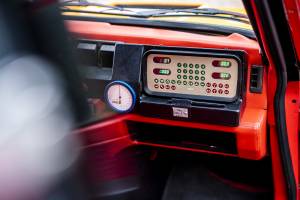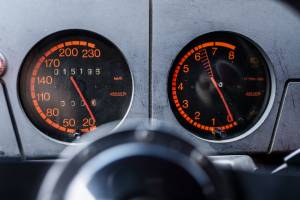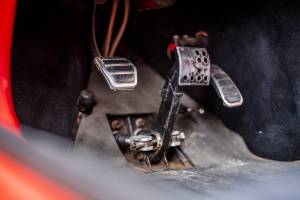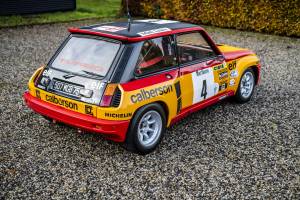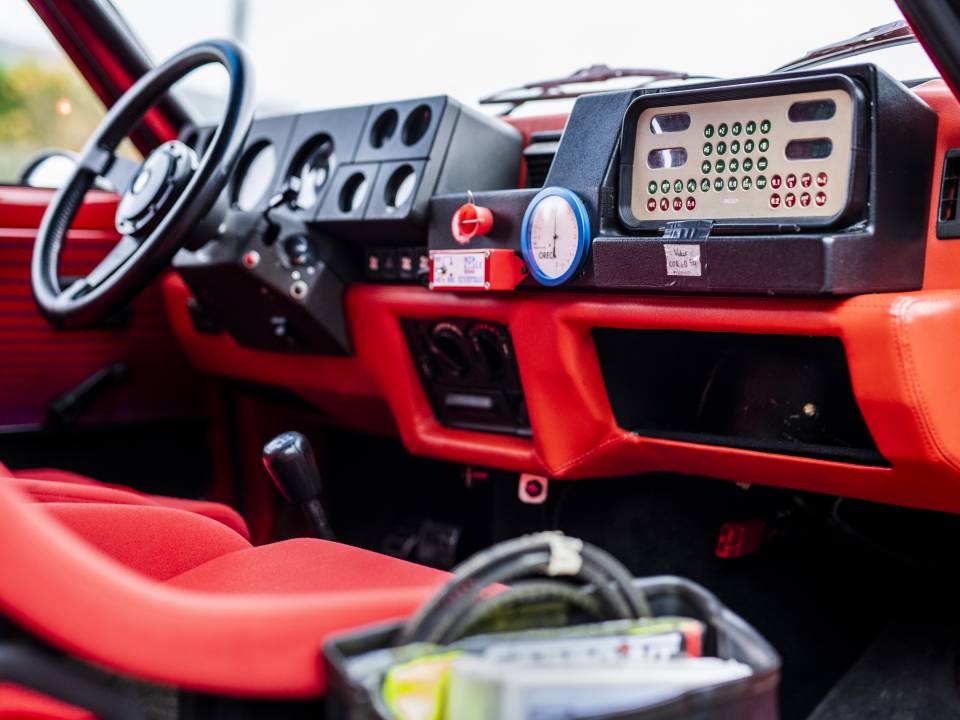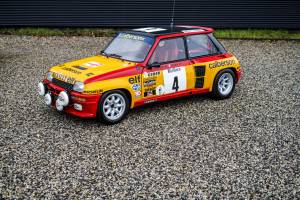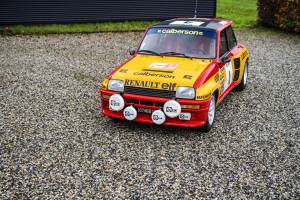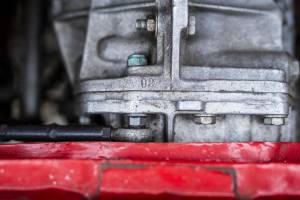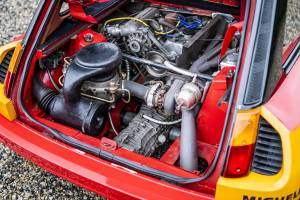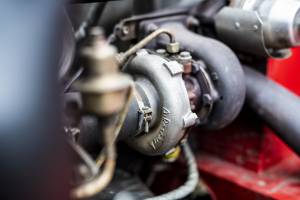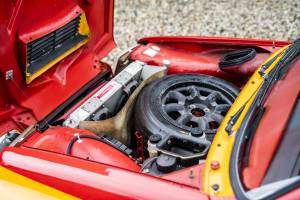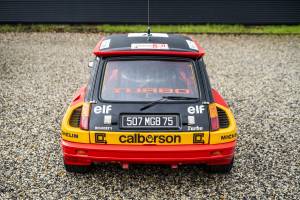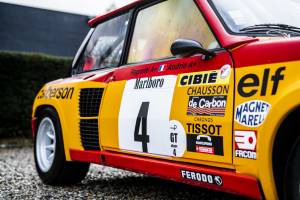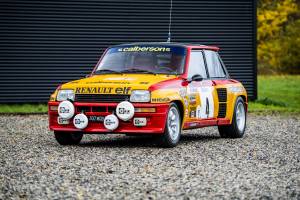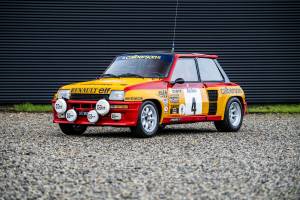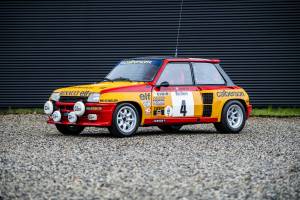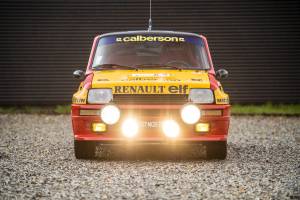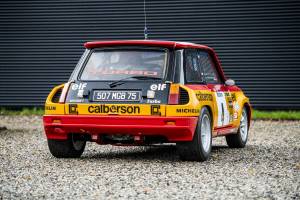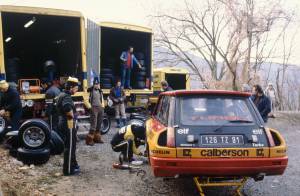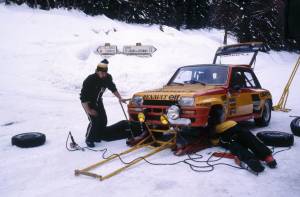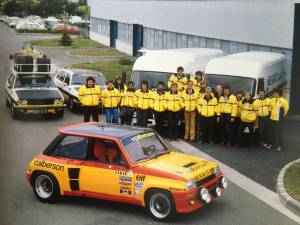1980 | Renault R 5 Turbo 2
WORKS RALLY GROUP 4
WORKS RALLY GROUP 4
Beschreibung
This remarkable survivor was the first R5 Turbo to be homologated for Group 4 and the only original and unrestored Calberson sponsored Renault 5 Turbo Works Rally Group 4 car still surviving. Driven by factory driver Jean Ragnotti on the 1980 Tour de France Automobile as well as the Tour de Corse, this is one of the most important R5 Turbo factory cars – it remains highly original today and is a striking and evocative piece of Group 4 Rally history.
The legendary Renault 5 Turbo was born out of the vision of Jean Terramorsi, deputy director of product management at Renault, who, in 1977, envisaged competition potential for the star of the Fleet, the compact Renault R5. For Terramorsi it was not enough to just improve road holding and power output as with the R5 Alpine; Terramorsi considered it necessary to build a proper rally car, benefiting from cutting-edge turbo technology as seen on the out-and-out racing cars competing in Formula One and endurance racing.
In 1972, Bernard Dudot, engineer at Alpine in Dieppe, had installed a turbo on a 1600 engine to boost the power of a very light Group 5 Berlinetta and the result was an almost undrivable car; but in the skilled hands of a champion like Jean-Luc Thérier, it would go on to win the criterium of the Cévennes proving its potential. Although not known at the time, it was this car that would pave the way for the Renault 5 Turbo. With its turbocharged mid-mounted engine, reinforced chassis, special gears, monocoque body combining steel, polyester and aluminum and extravagant rear track the all-new R5 Turbo competition car was set to be a giant killer, as it so nearly was on the Tour d‘Italia in 1979, where Guy Fréquelin gave the Stratos’s and Porsches a hell of a fright before being forced to retire.
In 1979, the small Renault Sport team in charge of the R5 Turbo rally program, including François Bernard (chassis engineer) and Michel Têtu, had only built the Group 5 prototype, the famous “black” R5 which was an assembly of specific parts of Renault or Alpine origin. Gérard Larousse and his team had to wait for the production of 400 examples of the production car to obtain Group 4 homologation to permit the R5 Turbo to enter major international events - this was obtained in September 1980 just before the Tour de France Automobile. It was therefore necessary to build a new car benefiting from the lessons learned testing the "black" prototype and thus the car presented here was born. Chassis number B000036, registered 126 TZ 91 on September 8, 1980, was the very first R5 Turbo homologated for racing in Group 4.
Chassis B000036 immediately received the sensational and iconic orange and red Calberson livery of the well-known transport and courier company. Calberson had originally forged links with Alpine and Renault through their sponsorship of the A310 V6 champion of France driven by Guy Frequelin as well as the Alpine R5s, the small "skateboards”, which had achieved so much with Frequelin and Ragnotti in Monte Carlo in 1978 and finally the Alpine Renault A442 at Le Mans.
Coco Prié, the famous Alpine assistance mechanic from the heyday of the 1973 World Championship, who joined Renault Sport at the end of 1978 as rally assistance manager, remembers having assembled this particular R5Turbo not at Viry Châtillon, but at Antony, in the Formula 1 department next to Prost's single seater. The 1400 turbocharged engine was therefore prepared by Philippe Chasselut and Philippe Coblence under the guidance of Bernard Dudot. It is, moreover, the first and the only R5T engine to have benefited from this preferential treatment, the other mechanicals being installed in Viry and then at the Bozian brothers’ in Lyon. This engine is more-or-less the same as that of the "Tour de Corse" version which appeared in 1983, but a little less powerful (around 260 hp according to the press of the time) and there are some notable special features compared to a series R5T:
• Chausson air / water exchanger
• Large probe plate from Porsche 928, where only 4 out of 8 outlets are used, with a large air filter placed on the left side
• Specific turbocharger placed to the right of the engine compartment, and without waste gate (the turbo relief valve when the pressure is too high), the latter being located directly on the exhaust manifold which is specific
• Exhaust outlet on the right
• Installation of a large alternator above the gearbox
• Dry sump with oil tank on the right side, and specific timing cover with chain-drive off the oil pump.
• Close-ratio gearbox, ZF self-locking at 40%
• Specific pedal-box with double master cylinders as fitted to single-seat racing cars
This engine specification remained unchanged up until the "Tour de Corse" variant, which developed up to 320 horsepower. Later, the "Maxi" version would appear, a big technical evolution, giving a power output of 350hp and greater flexibility. There are also differences on the running gear which include specific mounts on the brakes (4-piston clamps at the front, 2 pistons at the rear and special discs for Group 4), factory-reinforced and adjustable rear lower wishbones, De Carbon shock absorbers and a modified front end with mechanically welded upper wishbones. The rims are 15-inch magnesium Minilites. This R5T Group 4 retains its original front wheel arches, which gives it a very narrow track compared to the rear, a look that is synonymous with the early R5T’s. This was changed on the later cars (Group 4 and Group B) which would go on to be fitted with wider front wheel arches and 16-inch rims.
B000036’s first outing was the famous Tour de France Automobile of 1980, which, was held at the end of September over a distance of 2700km. This car was very lucky as it was handed to the legendary factory Work’s driver Jean Ragnotti, assisted by Jean Marc Andrié for the race. Andrié said at the time "the mechanics presented us with a magnificent car - the most beautiful rally car I have ever seen". Coco’s crew worked on the car throughout the night in preparation for the race which took place in an atmosphere of hungry and excited anticipation. The Ragnotti-R5T kicked-off with a scratch win on the opening special-stage and finished by going on to win six of the following stages.
Mechanical problems plagued what many believed would be Ragnotti's march to the podium - the gearbox had to be changed in Nîmes (this was achieved in an incredible 20 minutes - although Coco told us that the shortest time to change it had been timed at a remarkable 12 minutes!) - the exhaust manifold needed changing in the Moulinon after the Renault driver had put-in 2'56 '' at Darniche in the fog of the Burzet!
An excursion from the road on the Col de Perty meant more time lost and then ignition problems sealed their fate leading to retirement six stages from the finish. Despite incredible performances from the driver and co-driver paired with this turbo-charged pocket-rocket, the first outing for the R5T was not to end in a victory. However, the Calberson R5T had made a lasting impression on the spectators and gained tremendous popularity – they were not disappointed – they could see the potential!
The pairing of B000036 and Jean Ragnotti for the next event, the 1980 Tour de Corse, was excitedly anticipated and created a buzzing feeling of victory is imminent. The grueling event, with its stages of over 1000km, attracted the best of the best: Andruet, Thérier, Darniche, Frequelin, Rohrl, Saby, Mouton etc ... Jean Ragnotti was clear favourite given his results in the Tour Auto. Philippe Chasselut, Renault Sport’s in-house engine manufacturer, had put in many hours’ work to further reduce the lag time of the turbo. The pairing of the R5 and Ragnotti immediately set-the-pace over the first four stages but a puncture in the next one put him back to 4th place. Ragnotti quickly returned to the lead ahead of Darniche in the Fiat 131 Abarth and the second section was going to be all Ragnotti’s thanks to the appalling weather. In the Castagniccia, the pure talent of Ragnotti and the surprisingly well-mannered R5T in the wet, despite the violence of the turbo, allowed for the gap to widen. But shortly before the Col Saint Roch, the alternator belt broke and the car stopped - retirement was forced upon them quashing a certain victory - a huge disappointment for the entire Team and fans alike.
For the Criterium des Cévennes Rally of that same year, Ragnotti was given a Group 3 R5T in Calberson colors and registered 440 VB 91 (this same car would also serve Saby as his mount at the next Monte Carlo Rally). In preparation for this event, the Renault Sport Team also entered a new car painted in the same yellow, white and black livery as the Formula One cars and the Calberson liveried B000036 was used for tyre testing on snow with Jean Ragnotti. However, it was still the feature car on the cover of the 1980/81 Echappement! The car then returned to Renault Sport's reserves and was used for gravel testing by Ragnotti for the Wambergues, a famous brotherhood of drivers, to compare it with the all-new Audi Quattro (there is a film from the Wambergues of this practice session).
Roll forward to 1989 and B000036 was sold by the Renault Team to Mr. Jean Michel Gaudere, who kept and drove it on events in completely original Group 4 specification save for a few minor modifications. It was subsequently acquired by Renault Sporting Director and collector, Jean Sage, as part of his noteworthy collection. In 1997 Sage offered the car for sale at auction where it was bought by its penultimate caretaker, himself a driver, who entered it on the Rallye du Var and at the Tour de Corse Historique in 2013. As I can personally attest to, having been co-pilot in it during the historic Tour de Corse in 2013, the car remains an extremely capable and dynamic machine.
The present owner acquired the car at auction in 2014 and has made minor detail improvements including the fitment of the period correct aerial. It was also presented at the prestigious Chantilly Concours d’Elegance by the present owner in the summer of 2016.
Like its illustrious predecessor, the Alpine Berlinetta, this instantly recognizable and remarkably original Group 4 Rally star has entered into the Pantheon of heroic rally cars. B000036 is one of a handful R5 Turbos from the factory Works department to have remained Group 4 compliant, unmodified or improved with parts from the R5 Turbo Tour de Corse or Maxi 5 turbo. Its patina is remarkable as is its state of conservation, it still sports its original and distinctive colour-scheme and stickers (except for “The Tour Auto” specific stickers which were removed after the Rally for the next event, the Tour de Corse).
The R5T remains an instantly recognisable and much-loved icon of rally folklore and this particular example is presented today very close to “as raced in period” and in remarkably well-preserved condition. A very special opportunity indeed!
History and description taken from the French version written by noted specialist historian, Gilles VALLERIAN.
Below is an excerpt taken from the Sports Car Market Analysis following the cars sale at auction in 2014:
“All this is what makes this particular rally car such a smart buy. A careful read-through of its résumé shows verifiable competition use — but not too much. The car appears to have been rallied only on tarmac, saving it the abuse of unpaved roads and jumps. Plus, its tarmac career was mercifully short and devoid of reported crashes. The car’s short history was heavy on glory — even though it never won any rallies — and it appears to be straight, clean, and almost original to its Group 4 specifications. This car comes with a verifiably glorious racing history and without obvious flaws and is ready to compete in Europe’s active Historic Rally series. The price paid sets a new high-water mark for these cars. I’d call this one fairly bought and well sold. It seems this buyer knew what he was doing.”
Fahrzeugdetails
Fahrzeugdaten
- Marke
- Renault
- Modellreihe
- R 5
- Modell
- R 5 Turbo 2
- Erstzulassung
- Nicht angegeben
- Baujahr
- 1980
- Tachostand (abgelesen)
- Fahrgestellnummer
- B000036
- Motornummer
- Nicht angegeben
- Getriebenummer
- Nicht angegeben
- Matching numbers
- Nein
- Anzahl Besitzer
- Nicht angegeben
Technische Details
- Karosserieform
- Limousine (3-Türen)
- Leistung (kW/PS)
- 191/260 (ab Werk: 118/160)
- Hubraum (cm³)
- 1397
- Zylinder
- 4
- Anzahl Türen
- 3
- Lenkung
- Links
- Getriebe
- Manuell
- Gänge
- 5
- Antrieb
- Heck
- Bremse Front
- Scheibe
- Bremse Heck
- Scheibe
- Kraftstoff
- Benzin
Individuelle Konfiguration
- Außenfarbe
- Andere
- Herstellerfarbe
- Calberson colors
- Innenfarbe
- Rot
- Innenmaterial
- Alcantara
Zustand & Zulassung
- Zustandskategorie
- Original
- Gutachten vorhanden
- Nicht angegeben
- Zustand
- Zustandsbericht beauftragen
- Zugelassen
- Fahrbereit
Anfahrt

P.J. WALLMAN CLASSIC SPORTING MOTOR CARS & MOTOR BOATS
Peter Wallman
London
London London
🇬🇧 Vereinigtes Königreich
